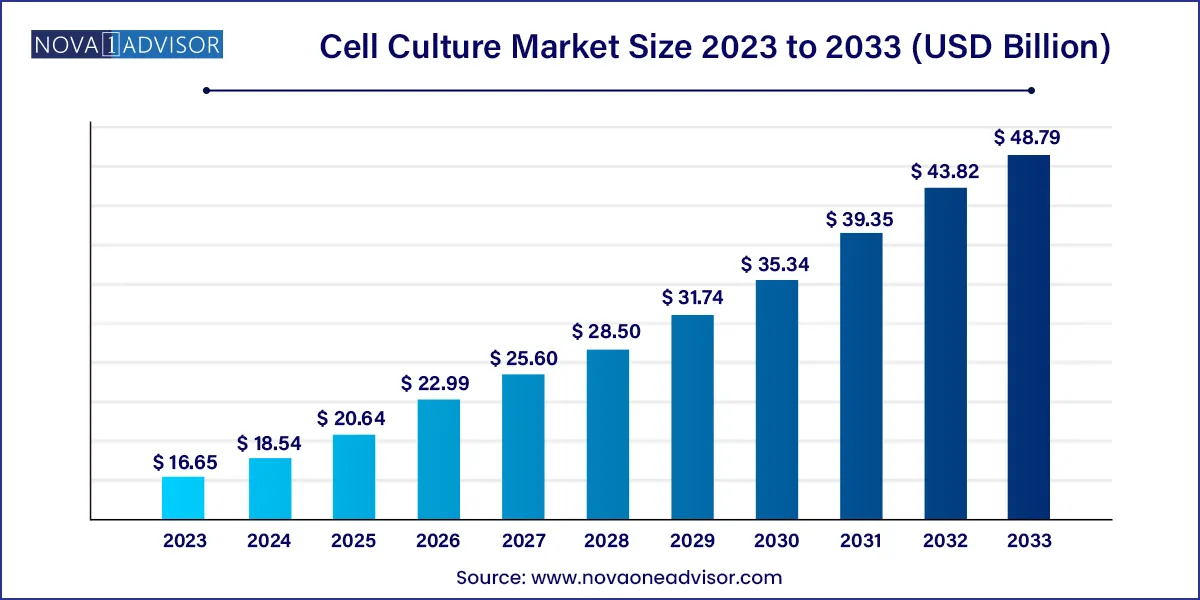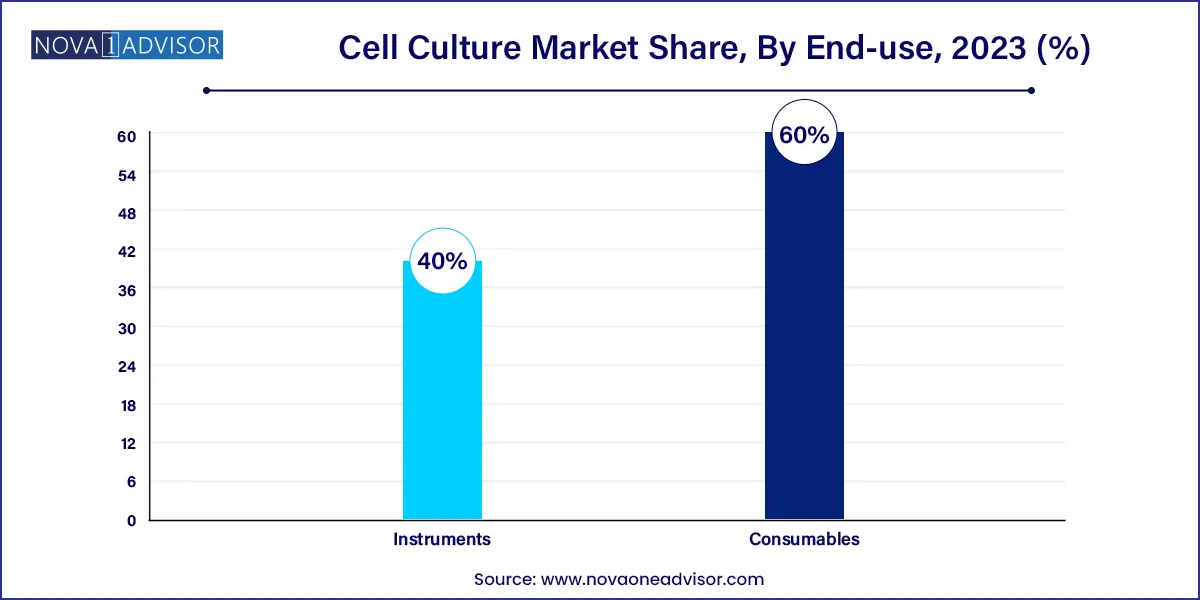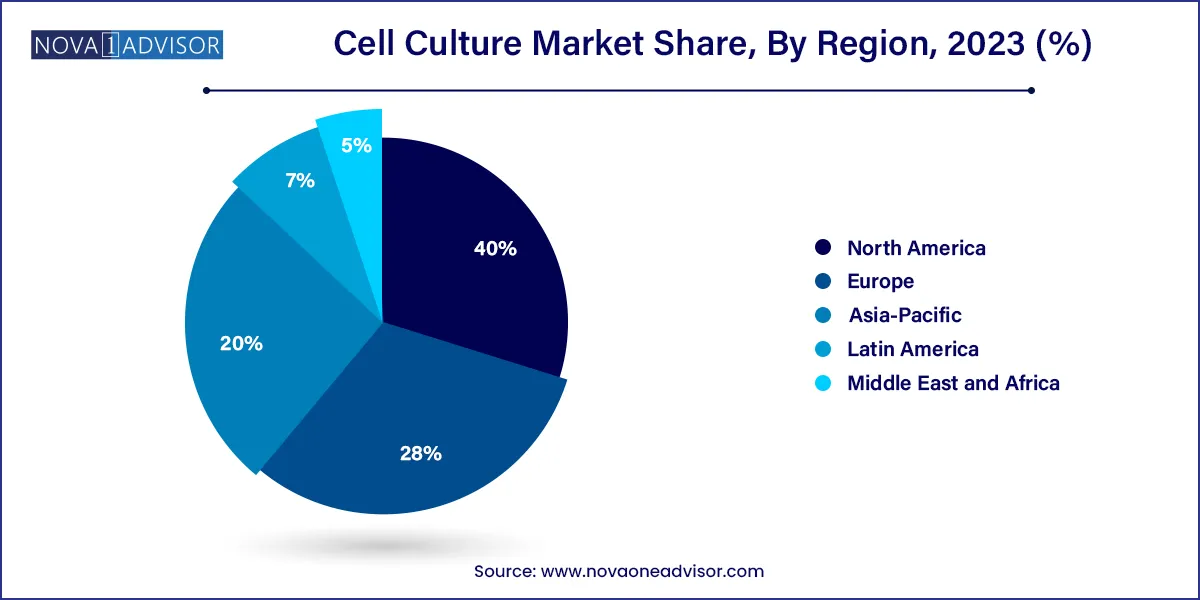The global cell culture market size was exhibited at USD 16.65 billion in 2023 and is projected to hit around USD 48.79 billion by 2033, growing at a CAGR of 11.35% during the forecast period 2024 to 2033.

Key Takeaways:
Cell Culture Market Report Scope
| Report Coverage | Details |
| Market Size in 2024 | USD 18.54 Billion |
| Market Size by 2033 | USD 48.79 Billion |
| Growth Rate From 2024 to 2033 | CAGR of 11.35% |
| Base Year | 2023 |
| Forecast Period | 2024-2033 |
| Segments Covered | Product, Application, Region |
| Market Analysis (Terms Used) | Value (US$ Million/Billion) or (Volume/Units) |
| Regional Scope | North America; Europe; Asia Pacific; Central and South America; the Middle East and Africa |
| Key Companies Profiled | Sartorius AG; Danaher; Merck KGaA; Thermo Fisher Scientific, Inc.; Corning Inc.; Avantor Inc.; BD; Eppendorf SE; Bio-Techne; PromoCell GmbH |
Its growth can be attributed to the rapid adoption of cell culture techniques to develop substrates for the safe production of viral vaccines, and the rising global demand for advanced therapy medicinal products. Furthermore, novel three-dimensional cell culture techniques and the growing need for them in biopharmaceutical development & vaccine production are expected to drive the market growth over the forecast period. The COVID-19 pandemic has presented researchers with the opportunity to investigate the novel contagious virus for the creation of therapeutic and diagnostic tools.
Numerous prominent pharmaceutical and biotechnology companies have been engaging in extensive R&D efforts to produce innovative vaccines, therapies, and testing kits. As a result, there has been a substantial increase in the need for cell culture tools in research applications. Furthermore, the pandemic has increased the demand for new cell-based models, organoids, and high-throughput screening platforms for research & drug discovery efforts. The urgency to combat the pandemic increased the demand for bioreactors and culture systems for applications in vaccine production and drug testing during the pandemic. In addition, several emerging and established players undertook various initiatives to capitalize on the increased demand for cell culture products due to the COVID-19 pandemic.
For instance, in January 2021, Captivate Bio, based in Massachusetts, U.S., launched its portfolio of cell culture tools for accelerating research applications for COVID-19 and other emerging diseases. Furthermore, in August 2023, Thermo Fisher Scientific expanded its New York-based dry powder media manufacturing facility to support the global demand for media products required for manufacturing COVID-19 vaccines and other biologics. Such initiatives are likely to positively impact the market growth over the forecast period. Furthermore, cell culture technology has applications in the development of functional tissues and organs as it enables researchers to create artificial organs that can replace damaged or malfunctioning organs in patient
The potential impact of artificial organs in improving the quality of life for patients with organ failure is substantial and can drive the demand for cell culture techniques. In addition, cell culture-based vaccine production has gained prominence in recent years due to several advantages, including improved safety and faster production timelines offered by such vaccines. As a result, cell culture technology is being widely used for the production of several U.S.-licensed vaccines, including those for polio, rotavirus, smallpox, rubella, hepatitis, and chickenpox. Similarly, cell-based flu vaccines have been approved for use in several European countries. Hence, with the growing healthcare awareness and rising demand for vaccines, the market is anticipated to witness rapid expansion in the near future.
Segments Insights:
Product Insights
The consumables segment accounted for the largest market share of 60.0% in 2023 and is expected to witness significant growth during the forecast period primarily due to recurring demand and purchase of consumables. Another factor propelling the segment growth is increased R&D expenditure by biotechnology & biopharmaceutical businesses to develop sophisticated biologics, such as monoclonal antibodies & vaccines. Consumables are expected to continue to havea high demand during the forecast period. The consumables segment is further categorized into reagents, media, and sera.

The cell culture media segment accounted for the largest share of 42.76% of the consumables market in 2023. An increase in R&D investments and an upsurge in life sciences industries, particularly biopharmaceutical products, and the expansion of the biotechnology industry all contribute considerably to the growth of the media market. Furthermore, increased interest in stem cells and their progressive applications in research in biotechnology are likely to drive market expansion.
Application Insights
The biopharmaceutical production application segmentdominated the market in 2023 with a revenue share of 32.15%. Biopharmaceutical applications of cell culture techniques are anticipated to expand due to the use of mammalian cell lines, such as the Chinese hamster ovary, in the production of biopharmaceuticals and the increasing demand for alternative medicines. Furthermore, the recent innovations in grafting procedures and new alternatives in personalized therapy have broadened the biopharmaceutical domain's potential.
The diagnostics segment is expected to grow at the fastest CAGR of 14.29% from 2023 to 2033. Cell cultures can be used in metabolomics for the identification of biomarkers of pathologically relevant conditions. Similarly, metabolites also play a crucial role in the diagnosis of cancer and its recurrence, which increases the scope of applications for cell culture media products in disease diagnosis.
Regional Insights
North America held the largest market share of 40.0% in 2023. The large share is attributed to the region’s well-established pharmaceutical & biotech sectors and widely used, technologically advanced solutions in the U.S. In addition, there is a large market for cell culture technologies due to the extensive cell therapy research efforts undertaken by several universities. The need for cell culturing technologies in research & clinical applications is further augmented by the growing prevalence of chronic & infectious diseases in this region.

The Asia Pacific region is projected to expand at the fastest CAGR of 13.79% over the forecast period due to the growing healthcare expenditure, rising awareness regarding cell and gene therapies, and a large potential for clinical research applications. Furthermore, the rapid adoption of scientific technologies and emerging therapeutics, such as regenerative medicines and cancer immunotherapies, is likely to strengthen the region’s growth in the near future.
Some of the prominent players in the Cell culture market include:
Segments Covered in the Report
This report forecasts revenue growth at global, regional, and country levels and provides an analysis of the latest industry trends in each of the sub-segments from 2021 to 2033. For this study, Nova one advisor, Inc. has segmented the global cell culture market.
Product Scope
Application
By Region